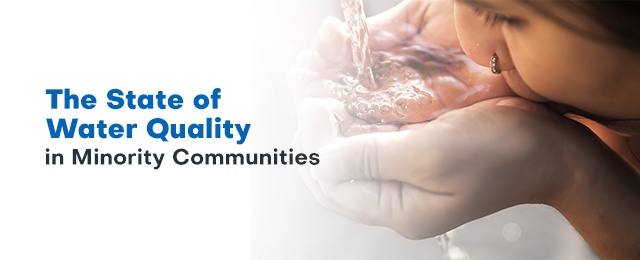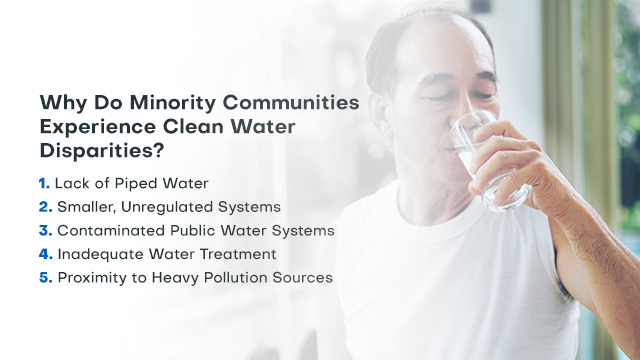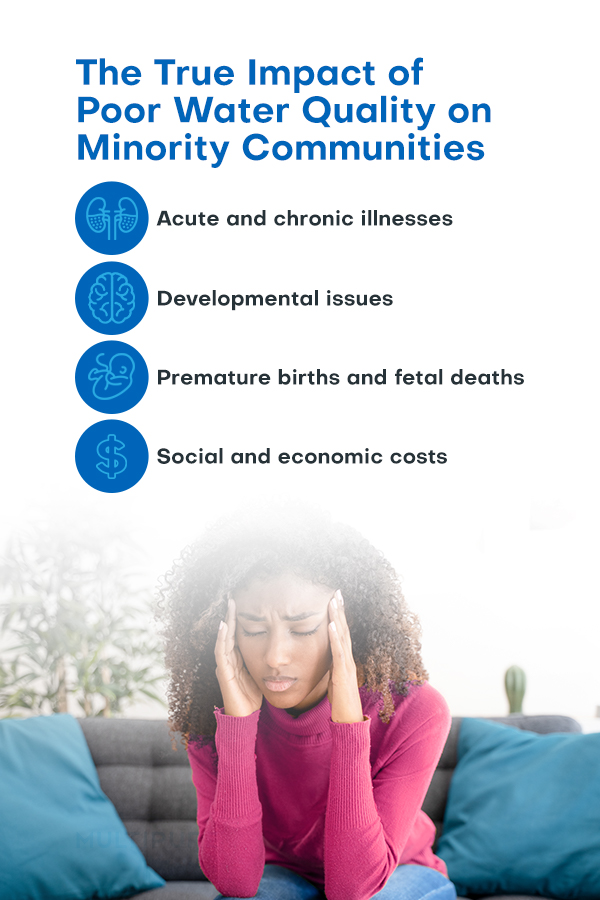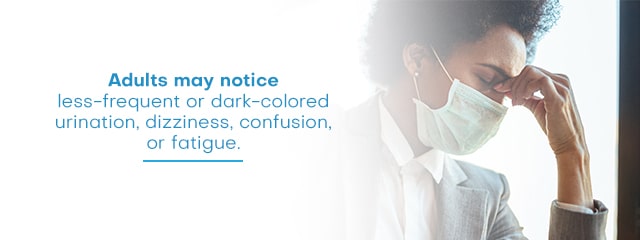The State of Water Quality in Minority Communities
Posted by admin on Jun 29th 2021

Water quality nationwide various tremendously by location, with nearly
130 million people receiving their water from drinking water systems where contaminant levels violate the law. These violations often disproportionately affect minority and low-income communities. The Natural Resources Defense Council (NRDC) recently analyzed U.S. Environmental Protection Agency (EPA) water quality data from 2016 to 2019 and discovered that years-long drinking water violations are 40% percent more likely to occur in communities with higher percentages of minority residents.
Water pollution is a long-standing issue. For years, water quality issues have cropped up across the United States, and they have not always received the resolution they deserved. Every year, more challenges arise, and disparities in water quality grow. What are the impacts of poor water quality on minority communities, and what can we do to address them?
What Does Water Quality Really Mean?
What is water quality? This phrase can be difficult to define precisely, especially since good water quality means different things to different people. The values consumers ascribe to their water quality may take many forms, including these:
- Good taste
- Free from odor
- Minimal or acceptable health risks
- Low cost
- Strong pressure
- Abundance
- Convenience
- Reliability
- Availability of reliable data about these measures of quality
We can also describe water quality in terms of the water's chemical, physical, and biological content:
- Chemical: All water contains chemical impurities, but some are more critical to measure or occur in higher concentrations. Water quality tests can measure the levels of compounds from common contaminants like fertilizers, pesticides, and other runoff from nearby industries, with levels over the maximum contaminant level (MCL) or maximum contaminant level goal (MCLG) indicating poorer water quality.
- Physical: The physical measurements for water quality often include temperature, depth, velocity, flow rate, and turbidity. These measurements provide vital information about how contaminants interact with the water at its source.
- Biological: The biological measurements for water quality often include what organisms are growing in the groundwater and surface water that act as drinking water supplies. For instance, water that contains blue-green algae may also contain cyanotoxins that reduce the water's quality and make it unsafe to drink.
Who Determines Good Water Quality?
In the United States, the Safe Water Drinking Act regulates water quality. In the 1970s, nationwide studies revealed extensive water quality issues and potential health risks throughout the country. As many as
40% of America's drinking water systems failed to meet basic health criteria. In response, Congress passed the Safe Drinking Water Act (SDWA) in 1974 to protect public health by regulating the most common harmful contaminants. The EPA enforces drinking water standards through this act.
The SDWA applies to water systems that have at least 15 connections or serve at least 25 people. It addresses drinking water quality in two main ways — it oversees the quality of drinking water from public water systems, and it mandates protections for drinking water sources like groundwater and aquifers.
The SDWA accomplishes several key objectives:
- Requires the EPA to set enforceable MCLs for drinking water contaminants, as well as optional MCLGs
- Allows states to take primary responsibility for enforcing MCLs
- Authorizes the EPA to take drinking water enforcement actions if water systems fail to meet MCL criteria
- Requires public water systems to notify customers of violations
- Requires the EPA to establish minimum safety requirements for wastewater
- Gives the EPA emergency authority to address contaminant levels that pose an acute threat to public health
- Authorizes regulations for record-keeping and monitoring
- Allows for citizen suits against utilities that violate SDWA requirements
Why Do Minority Communities Experience Clean Water Disparities?
What are the main causes of poor water quality in minority communities? One of the most significant issues is a lack of proper water infrastructure. Where minority neighborhoods overlap with low-income neighborhoods, strained financial resources sometimes mean aging water infrastructure with a higher potential for contamination.

Here are a few ways in which insufficient infrastructure and environmental challenges lead to clean water disparities:
1. Lack of Piped Water
Even though the vast majority of communities receive piped drinking water, a few do not. For instance, one study has found that
30% of Navajo Nation residents lack piped water.
The health consequences are severe — of the available water sources, more than 70% tested positive for total coliform bacteria, and 21% tested positive for Escherichia coli. Another 12% had arsenic concentrations above the EPA's MCL, while 5% had uranium concentrations above the MCL.
2. Smaller, Unregulated Systems
In some communities with piped water, the water system is too small to fall under the SDWA's governance. About
14% of U.S. residents rely on these smaller or individual systems, where contaminant levels can easily creep upward in the absence of official oversight.
In Washington's Yakima Valley, for instance, about 25,000 Hispanic residents have relied on groundwater where
12% of the wells exceeded the MCL for nitrate. The predominantly minority migrant camps served by these small water systems also tend to have persistent, severe issues with microbial and pesticide contaminants.
3. Contaminated Public Water Systems
The public water systems serving minority communities sometimes provide lower-quality water because local financial resources are stretched thin, and infrastructure upgrades become impracticable.
Disparities in the availability of construction funds might lead to neglect of physical infrastructure and issues with water quality or reliability. Inequities in management quality might affect the thoroughness of operator training, the trustworthiness of water treatment, or the level of regulatory compliance.
In California, the Environmental Justice Coalition for Water has found that the counties with the most water quality violations have higher proportions of Latino residents than the counties with the fewest violations. The counties with the most violations had about
46% Latino residents, while the counties with the fewest violations had only 16% Latino residents.
Additionally, the proportion of Latino residents in an area has been shown to correlate with
higher nitrate levels in drinking water. Nitrates often have a positive correlation with other pollutants like pharmaceutical residues and contaminants from chemical products, so these additional substances may disproportionately affect Latino residents' drinking water as well.
Lead service lines are also more common in older neighborhoods, which tend to have higher proportions of minority residents. For this reason, minority communities are often at higher risk of elevated lead concentrations in their drinking water.
4. Inadequate Water Treatment
In some cases, insufficient water treatment plays a role in contaminating the drinking water in minority communities. Flint, Michigan, a city with a
62% minority population, and its water crisis of 2014 to 2018 can illuminate this matter.
The water crisis began when the city turned to the Flint River as a temporary water source and failed to treat the river water sufficiently. The untreated water
corroded many of the city's older lead pipes, allowing lead to leach into the drinking water. The untreated water also contained harmful contaminants like E. coli and coliform bacteria. Nearly 100,000 people, including 6,000 to 12,000 children, became exposed to lead in their drinking water, and fetal deaths spiked by 58%.
5. Proximity to Heavy Pollution Sources
Some communities are close to contaminant sources like factories, agricultural operations, or wastewater treatment plants. The pollution from these sources frequently seeps into the
local water supply and diminishes its quality.
Certain high-output pollution sources are known as toxic outliers because they generate the most toxic exposure risk — this small 10% of polluters tends to produce more than
90% of the pollution. Toxic outliers significantly affect minority and low-income areas — of the 100 worst offenders, the top 10 have disproportionate impacts on disadvantaged communities. Minority and low-income residents tend to live closer to these facilities than other residents, and they bear more than half of the human health risk in these regions.
The True Impact of Poor Water Quality on Minority Communities
How does water pollution affect your community? Poor water quality has an impact on health and social factors. It can cause both short-term and long-term health consequences and diminish the value of social experiences. Here are a few of those detrimental effects:

- Acute and chronic illnesses: Studies have linked water pollutants to a host of illnesses and health conditions, including chronic kidney disease, certain cancers, skin ulcerations, asthma, allergic rhinitis, hypertension, coronary artery disease, heart arrhythmias, and cerebral palsy.
- Developmental issues: Studies have also linked contaminants like lead to developmental delays in children, including behavioral and learning problems, diminished IQs, hyperactivity, slowed growth, and hearing issues.
- Premature births and fetal deaths: Contaminants like lead can lead to a high number of premature births and fetal deaths in a community. Additionally, high nitrate levels in the water supply can lead to methemoglobinemia, known colloquially as blue-baby syndrome. This condition causes difficulty breathing, a bluish tinge to the skin, and death in extreme cases.
- Social and economic costs: Poor water quality can diminish a community's social interactions and economic opportunities. Polluted lakes and rivers, for instance, provide fewer enjoyable social opportunities for residents, attract fewer tourists for water recreation, and can depress a region's economic growth by up to one-third.
The Government's Role in Improving Water Quality in Minority Communities
The government of any community is responsible for creating and enforcing laws that promote its residents' safety and welfare. Local governments and the federal government can take several steps to improve water quality, including the following:
- Establishing fair policies: Local governments should ensure equitable policies for all residents. They might step in to prohibit the construction of a polluting facility near a minority community or allocate funds toward upgrading existing infrastructure in older communities.
- Enforcing violation penalties: When water utilities fail to meet EPA standards for drinking water quality, local governments step in to ensure those utilities receive the appropriate penalties.
- Developing emergency response protocols: Local governments can craft emergency response protocols that enable a swift response to a developing water crisis. These protocols might include setting aside an emergency fund that authorized personnel can access to replace failed infrastructure quickly.
However, government bodies can only do so much to improve and maintain local water quality. To protect their health and peace of mind, individuals often need to take action on their own to prevent contaminants from reaching their homes' water.
What Can Communities Do to Protect Their Water Quality?

To reduce contaminant levels and protect their water quality, communities can take a few different steps in their day-to-day lives:
- Pick up pet waste: Germs from pet waste can contaminate the soil, seep into runoff, and make their way into the groundwater. Picking up pet waste immediately and encouraging other residents to do the same can help minimize this issue.
- Reduce fertilizer use: Nitrates and other nutrients from fertilizer can also run off and contaminate water supplies. Using only the fertilizer you need helps prevent nutrient pollution, algal overgrowth, and contaminated drinking water.
- Encourage well testing: If a significant portion of your community relies on private well water, encourage regular well testing to monitor contaminant levels. That way, even without EPA oversight, residents can keep their drinking water clean and healthy.
- Develop a community stewardship plan: Community-wide efforts help as well. Consider how your neighborhood or town can band together to prevent erosion, test contaminant levels in streams and lakes, and make your voices heard in city council meetings and state legislative sessions.
- Invest in home drinking water solutions: If the municipal drinking water system fails to meet established health guidelines, community members can take individual action to protect themselves. Choosing a home drinking water system enables homeowners to reduce contaminant levels in their drinking water and gain peace of mind about their families' health.
Introducing Water Purification Systems to Your Community
Fortunately, Multipure offers a way for individuals to take control of their water quality and provide their families with clean, safe drinking water. Introducing our water filtration and purification systems is an excellent way to boost water quality and feel more confident about community health.
At Multipure, our home drinking water systems come with sophisticated carbon block filters that trap and reduce a tremendous
array of contaminants, from asbestos and chlorine to lead, mercury, volatile organic compounds (VOCs), and miscellaneous physical particulates, to name just a few. When you need clean, refreshing, healthful drinking water in your home, products like these Multipure drinking water systems provide outstanding benefits:
- Aquamini: Multipure's compact Aquamini is ideal for minimizing pollutants like asbestos, VOCs, chlorine, mercury, lead, pharmaceutical residues, and contaminants from pesticides like DEET. It sits on your countertop or below your sink to make your drinking water cleaner and more healthful. It is economical and portable, so you can use it in a small home or apartment or take it with you when you travel.
- Aquaversa: Multipure's Aquaversa is an outstanding mid-range solution that installs under your sink or as an extension of your kitchen faucet. It reduces contaminants like particulates, lead, mercury, chlorine, and VOCs, as well as a few others like chloramine and radon. It provides an excellent blend of performance and value for any home.
- Aquaperform: Multipure's Aquaperform offers superior performance, filtering an array of contaminants like lead, mercury, chlorine, asbestos, and VOCs, as well as additional impurities like arsenic and chloramines. It installs either under your sink or on your kitchen faucet and is an excellent choice for households with arsenic in the water who are seeking a comprehensive filtration solution.
- Aqualuxe: Multipure's Aqualuxe is our premier drinking water system and purifier. It is certified to reduce concentrations of the standard array of contaminants, as well as biological contaminants like bacteria and viruses and "forever chemicals" such as perfluorooctanoic acid (PFOA) and perfluorooctane sulfonate (PFOS). It is an excellent choice for households seeking the most advanced level of water purification and protection.
Trusted Home Drinking Water Solutions From Multipure

To take control of your water quality, improve your health and hydration and provide fresh, safe water for your family, by purchasing
purchase a dependable home drinking water system from Multipure. Our drinking water systems contain advanced carbon block filters that reliably reduce contaminant levels to leave you with fresh, great-tasting, healthful water. We've also backed our drinking water systems with NSF certifications for aesthetic and health-related contaminants to give you peace of mind about our products' quality and dependability.
Contact us today to purchase a home drinking water system or learn more.

